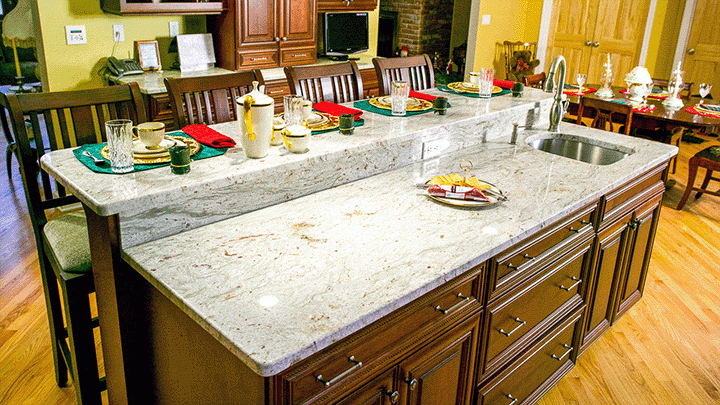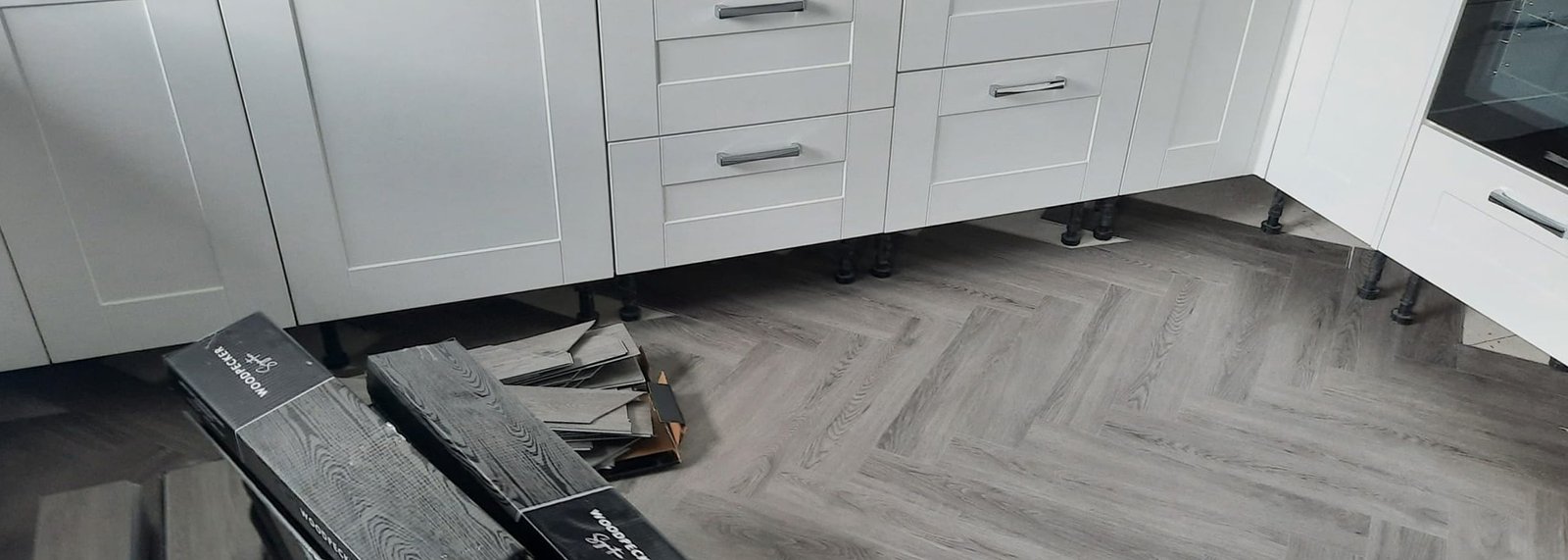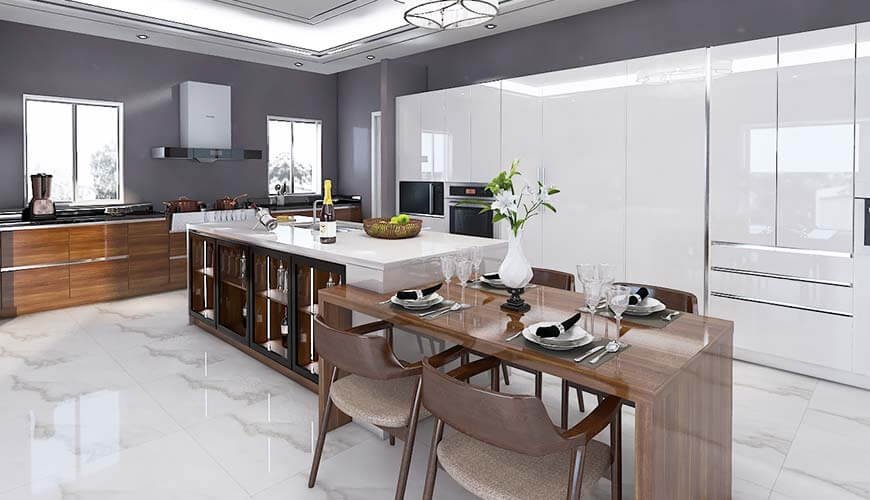You should not glue kitchen cabinets permanently. Use screws and brackets for secure and adjustable installation.
Gluing kitchen cabinets can lead to problems. Permanent adhesives make future repairs or adjustments difficult. Screws and brackets provide a secure and adjustable method for installing cabinets. This approach ensures that cabinets can be easily modified or fixed if needed.
Using screws also allows for the natural expansion and contraction of wood, reducing the risk of damage. Proper installation methods ensure durability and longevity for your kitchen cabinets. Choosing the right installation technique is crucial for maintaining the functionality and aesthetics of your kitchen. Always opt for methods that offer flexibility and ease of maintenance. This ensures your kitchen remains in top condition for years to come.

Table of Contents
TogglePros Of Gluing Cabinets
Gluing kitchen cabinets offers many benefits. It can make your kitchen more stable and durable. This section will explore the key advantages of gluing cabinets.
Increased Stability
Gluing cabinets provides extra stability. The glue holds the cabinets in place firmly. They are less likely to move or wobble. This extra support is crucial for heavy items. It keeps your dishes and cookware safe.
Also, glued cabinets can handle more weight. This is because the glue distributes the load evenly. The cabinets won’t sag or bend. This makes them perfect for busy kitchens. You can store more items without worrying.
Enhanced Durability
Gluing cabinets can extend their lifespan. The glue acts as a protective barrier. It helps seal the joints and edges. This prevents moisture from seeping in. Moisture can cause wood to warp or rot. Glued cabinets are less prone to damage.
The glue also reinforces the cabinet structure. It fills any tiny gaps or cracks. This makes the cabinets stronger. They can withstand daily wear and tear better. You won’t need to replace them as often.
In summary, gluing your kitchen cabinets increases stability and durability. It keeps them in good shape for years to come.

Cons Of Gluing Cabinets
Gluing kitchen cabinets might seem like a solid option. But, it comes with its own set of challenges. Understanding the downsides can save you from future headaches.
Difficulty In Removal
Glued cabinets are tough to remove. The adhesive creates a strong bond. This bond makes it hard to separate the cabinets without effort.
When you need to renovate, this can be a problem. Removing glued cabinets often requires professional help. This can increase your renovation costs.
Potential Damage
Gluing cabinets can lead to potential damage. The adhesive used can seep into the wood. This can make the wood brittle over time.
If you try to remove glued cabinets, it can damage the walls. The strong bond can rip off chunks of the wall. This can leave unsightly marks and holes.
Here are some potential damages:
- Wood splintering
- Wall damage
- Cabinet misalignment
Consider these factors before gluing your kitchen cabinets. The cons might outweigh the pros in the long run.
Types Of Glue For Cabinets
Choosing the right glue for your kitchen cabinets is crucial. The type of glue you use affects the durability and strength of the bond. Different types of glue serve different purposes. Here are some common options:
Wood Glue
Wood glue is specially formulated for bonding wood surfaces. It’s an excellent choice for kitchen cabinets made of wood. This glue creates a strong bond, ensuring your cabinets stay intact.
- PVA Wood Glue: This is the most common type. It dries clear and is easy to clean up.
- Polyurethane Wood Glue: It expands as it dries, filling small gaps.
Wood glue offers a reliable bond. It’s ideal for wooden cabinets.
Epoxy Adhesives
Epoxy adhesives are another option for kitchen cabinets. They are known for their high strength and durability. These adhesives are resistant to moisture and heat.
| Type | Features |
|---|---|
| Two-Part Epoxy: | Comes in two components that you mix before use. |
| Quick-Set Epoxy: | Sets quickly, reducing wait times. |
Epoxy adhesives are versatile. They offer excellent bonding strength for various materials.

Alternatives To Gluing
Gluing kitchen cabinets isn’t the only option. Explore different methods to secure your cabinets effectively. Alternatives include nailing and screwing, each with unique benefits.
Nailing
Nailing is a traditional method for joining kitchen cabinets. This method uses nails to hold the cabinet pieces together.
- Quick and Easy: Nailing is straightforward and requires minimal tools.
- Less Expensive: Nails are cheaper than screws and glue.
- Flexibility: Nails allow for slight adjustments during installation.
However, nailing may not provide the strongest bond. Consider the cabinet’s weight and usage before choosing this method.
Screwing
Screwing offers a more secure alternative to gluing. This method uses screws to attach cabinet pieces tightly.
- Strong Bond: Screws create a durable and long-lasting bond.
- Adjustability: Easily adjust or remove screws for future changes.
- Versatility: Suitable for various materials, including wood and metal.
Screwing requires more time and effort compared to nailing. Ensure you have the right tools and skills for this method.
Here’s a quick comparison between nailing and screwing:
| Method | Advantages | Disadvantages |
|---|---|---|
| Nailing | Quick, Easy, Less Expensive | Less Strong, Requires Adjustments |
| Screwing | Strong Bond, Adjustable, Versatile | Time-Consuming, Requires Tools |
Choose the method that best fits your needs and preferences. Both nailing and screwing provide excellent alternatives to gluing kitchen cabinets.
Preparation Before Gluing
Before you start gluing kitchen cabinets, proper preparation is crucial. This ensures a strong and durable bond. Skipping these steps can lead to poor adhesion and weak joints. Let’s dive into the important steps you need to take.
Surface Cleaning
Start by cleaning all surfaces that will be glued. Dust, grease, and grime can prevent glue from sticking properly. Use a damp cloth with mild soap to wipe down the surfaces. Let them dry completely before moving on.
For stubborn stains, use a gentle scrub brush. Avoid harsh chemicals that can damage the wood. Once cleaned, inspect the surfaces again. Ensure they are free from any remaining debris.
Dry Fitting
Dry fitting is essential before you apply glue. This step helps you check that all pieces fit together perfectly. Arrange all cabinet parts as they will be glued.
Use clamps to hold the pieces in place temporarily. This helps you see if any adjustments are needed. Mark alignment points with a pencil for easy reference later.
Here is a simple checklist for dry fitting:
- Arrange all parts in their final positions.
- Use clamps to hold parts together.
- Check for gaps or misalignments.
- Make necessary adjustments.
- Mark alignment points with a pencil.
Following these preparation steps ensures your kitchen cabinets will be sturdy and long-lasting. Proper preparation is key to a successful gluing process.
Step-by-step Gluing Process
Gluing kitchen cabinets ensures a strong, durable bond. Follow these steps to achieve a professional finish.
Applying The Glue
First, choose the right glue. Wood glue is ideal for kitchen cabinets. Ensure surfaces are clean and dry.
- Prepare the glue: Open the glue bottle and cut the tip.
- Apply the glue: Spread a thin, even layer along the edges.
- Use a brush: A small brush helps to spread glue evenly.
Clamping The Cabinets
Clamping ensures strong adhesion. It holds the pieces together firmly.
- Align the pieces: Make sure edges fit perfectly.
- Place clamps: Position clamps at regular intervals.
- Tighten the clamps: Secure them without over-tightening.
- Check alignment: Make sure everything is straight and level.
Leave the clamps in place for at least 24 hours. This ensures maximum strength.
| Step | Action | Tools Needed |
|---|---|---|
| 1 | Prepare the glue | Glue bottle |
| 2 | Apply the glue | Brush |
| 3 | Align the pieces | Hands |
| 4 | Place clamps | Clamps |
| 5 | Tighten the clamps | Clamps |
| 6 | Check alignment | Level |
Maintenance Tips
Glued kitchen cabinets need proper maintenance to ensure their durability. Regular care helps them last longer and stay in good condition. Here are some maintenance tips to keep your cabinets looking great.
Regular Inspections
Performing regular inspections is crucial. Look for any signs of wear or damage. Check the glue joints to ensure they are still holding strong.
Use the following checklist:
- Inspect glue joints
- Check for cracks
- Look for water damage
- Examine hinges and handles
Repairing Loose Joints
If you find loose joints, repair them immediately. Loose joints can weaken the cabinet structure.
Follow these simple steps:
- Remove any old glue
- Apply new wood glue
- Clamp the joint for a tight fit
- Let the glue dry completely
Regular maintenance keeps your kitchen cabinets looking new and ensures they last longer.
Expert Opinions
Gluing kitchen cabinets can be a debated topic. Experts have various viewpoints. Let’s explore these insights to help you decide.
Carpenter Insights
Carpenters often stress the importance of using glue. They believe glue enhances the durability of kitchen cabinets. Here are some key points:
- Strength: Glue adds additional strength to the joints.
- Longevity: Properly glued cabinets last longer.
- Stability: Glue prevents the cabinets from wobbling.
Carpenters also recommend specific types of glue:
| Type of Glue | Best Use |
|---|---|
| Wood Glue | General assembly |
| Epoxy | Heavy-duty applications |
| PVA Glue | Light repairs |
Choosing the right glue is crucial. Carpenters often recommend testing the glue first.
Diy Enthusiast Tips
DIY enthusiasts have their own tips and tricks for gluing kitchen cabinets. They often focus on ease and convenience. Here are some of their tips:
- Preparation: Clean surfaces before applying glue.
- Application: Use a small brush for even glue spread.
- Clamping: Clamp the pieces tightly for a better bond.
DIY enthusiasts also suggest using glue in combination with nails or screws. This method provides added security. They also emphasize safety:
- Wear gloves to protect your hands.
- Use goggles to shield your eyes.
- Work in a well-ventilated area.
By following these tips, you can achieve professional results. DIY enthusiasts believe anyone can do it with the right guidance.
Frequently Asked Questions
Is Gluing Kitchen Cabinets Recommended?
Gluing can add extra stability but isn’t always necessary.
What Glue Is Best For Kitchen Cabinets?
Wood glue is ideal for bonding kitchen cabinets.
Can Glue Replace Screws In Cabinets?
Glue alone can’t replace screws; both provide optimal strength.
How Long Does Cabinet Glue Take To Dry?
Wood glue typically dries within 24 hours.
Is Gluing Cabinets Cost-effective?
Gluing can be cost-effective, adding durability without high expense.
Does Glue Damage Kitchen Cabinet Materials?
Quality wood glue won’t damage most cabinet materials.
Should I Glue Cabinet Joints?
Gluing joints enhances stability and longevity.
Is Wood Glue Waterproof?
Most wood glues are water-resistant, not waterproof.
Can I Remove Glued Cabinets?
Removing glued cabinets can be difficult and may cause damage.
Will Glue Make Cabinets More Durable?
Yes, glue can significantly increase cabinet durability.
Conclusion
Gluing kitchen cabinets can enhance durability and stability. Consider your specific needs and material compatibility before deciding. Weighing the pros and cons ensures the best outcome. Remember, expert advice can guide you. Making informed decisions can lead to a successful and lasting kitchen renovation.


